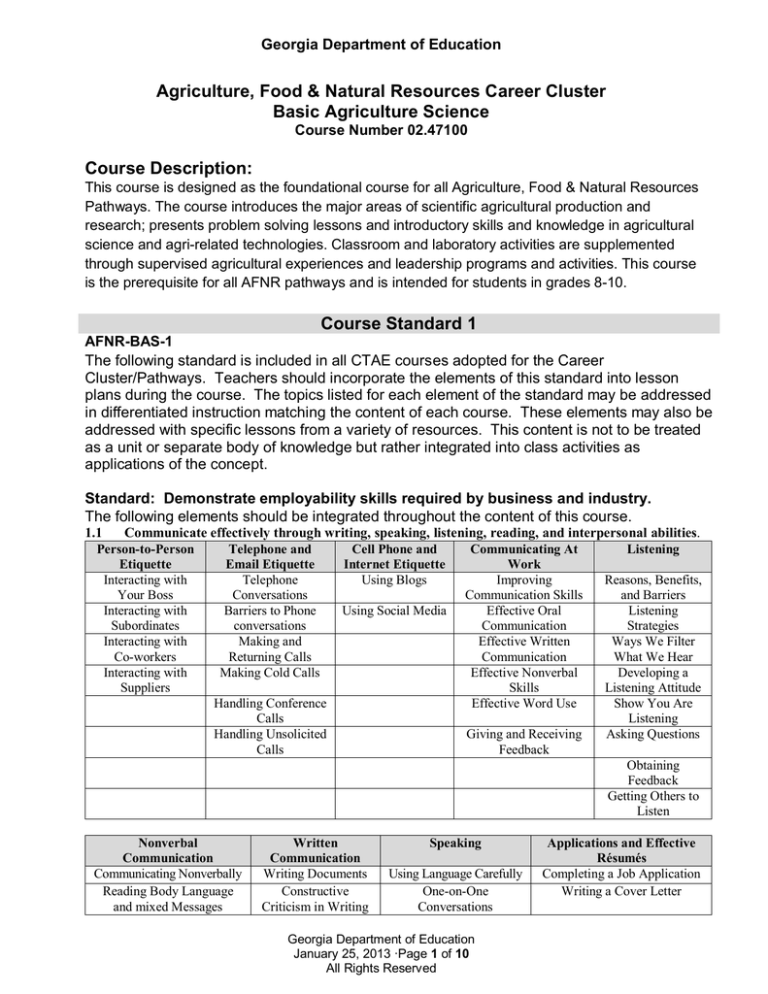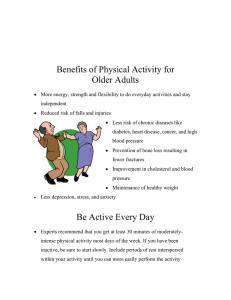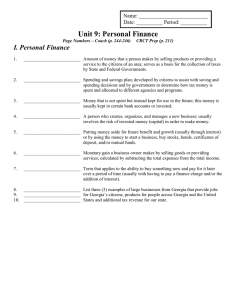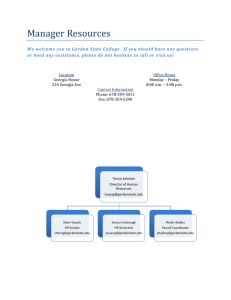
Georgia Department of Education
Agriculture, Food & Natural Resources Career Cluster
Basic Agriculture Science
Course Number 02.47100
Course Description:
This course is designed as the foundational course for all Agriculture, Food & Natural Resources
Pathways. The course introduces the major areas of scientific agricultural production and
research; presents problem solving lessons and introductory skills and knowledge in agricultural
science and agri-related technologies. Classroom and laboratory activities are supplemented
through supervised agricultural experiences and leadership programs and activities. This course
is the prerequisite for all AFNR pathways and is intended for students in grades 8-10.
Course Standard 1
AFNR-BAS-1
The following standard is included in all CTAE courses adopted for the Career
Cluster/Pathways. Teachers should incorporate the elements of this standard into lesson
plans during the course. The topics listed for each element of the standard may be addressed
in differentiated instruction matching the content of each course. These elements may also be
addressed with specific lessons from a variety of resources. This content is not to be treated
as a unit or separate body of knowledge but rather integrated into class activities as
applications of the concept.
Standard: Demonstrate employability skills required by business and industry.
The following elements should be integrated throughout the content of this course.
1.1
Communicate effectively through writing, speaking, listening, reading, and interpersonal abilities.
Person-to-Person
Telephone and
Cell Phone and
Communicating At
Listening
Etiquette
Email Etiquette
Internet Etiquette
Work
Interacting with
Telephone
Using Blogs
Improving
Reasons, Benefits,
Your Boss
Conversations
Communication Skills
and Barriers
Interacting with
Barriers to Phone
Using Social Media
Effective Oral
Listening
Subordinates
conversations
Communication
Strategies
Interacting with
Making and
Effective Written
Ways We Filter
Co-workers
Returning Calls
Communication
What We Hear
Interacting with
Making Cold Calls
Effective Nonverbal
Developing a
Suppliers
Skills
Listening Attitude
Handling Conference
Effective Word Use
Show You Are
Calls
Listening
Handling Unsolicited
Giving and Receiving
Asking Questions
Calls
Feedback
Obtaining
Feedback
Getting Others to
Listen
Nonverbal
Communication
Communicating Nonverbally
Reading Body Language
and mixed Messages
Written
Communication
Writing Documents
Constructive
Criticism in Writing
Speaking
Using Language Carefully
One-on-One
Conversations
Georgia Department of Education
January 25, 2013 ∙Page 1 of 10
All Rights Reserved
Applications and Effective
Résumés
Completing a Job Application
Writing a Cover Letter
Georgia Department of Education
Matching Verbal and
Nonverbal communication
Improving Nonverbal
Indicators
Nonverbal Feedback
Showing Confidence
Nonverbally
Showing Assertiveness
Small Group
Communication
Large Group
Communication
Making Speeches
Involving the Audience
Things to Include in a Résumé
Terms to Use in a Résumé
Describing Your Job Strengths
Answering Questions
Visual and Media Aids
Errors in Presentation
Organizing Your Résumé
Writing an Electronic Résumé
Dressing Up Your Résumé
Selling Yourself in a Résumé
1.2
Demonstrate creativity by asking challenging questions and applying innovative procedures and
methods.
Teamwork and Problem Solving
Meeting Etiquette
Thinking Creatively
Preparation and Participation in Meetings
Taking Risks
Conducting Two-Person or Large Group Meetings
Building Team Communication
Inviting and Introducing Speakers
Facilitating Discussions and Closing
Preparing Visual Aids
Virtual Meetings
1.3
Exhibit critical thinking and problem solving skills to locate, analyze and apply information in
career planning and employment situations.
Problem Solving
Customer Service
The Application Process Interviewing Skills
Finding the
Right Job
Transferable Job
Gaining Trust and
Providing Information,
Preparing for an
Locating Jobs
Skills
Interacting with
Accuracy and Double
Interview
and Networking
Customers
Checking
Becoming a
Learning and Giving
Online Application
Questions to Ask in
Job Shopping
Problem Solver
Customers What They
Process
an Interview
Online
Want
Identifying a
Keeping Customers
Following Up After
Things to Include in
Job Search
Problem
Coming Back
Submitting an Application
a Career Portfolio
Websites
Becoming a
Seeing the Customer’s
Effective Résumés:
Traits Employers are
Participation in
Critical Thinker
Point
Seeking
Job Fairs
Managing
Selling Yourself and
Matching Your Talents to
Considerations
Searching the
the Company
a Job
Before Taking a Job
Classified Ads
Handling Customer
When a Résumé Should
Using
Complaints
be Used
Employment
Agencies
Strategies for
Landing an
Customer Service
Internship
Staying Motivated
to Search
1.4
Model work readiness traits required for success in the workplace including integrity, honesty,
accountability, punctuality, time management, and respect for diversity.
Workplace Ethics
Personal
Employer
Business Etiquette
Communicating at
Characteristics
Expectations
Work
Demonstrating Good
Demonstrating a
Behaviors
Language and
Handling Anger
Work Ethic
Good Attitude
Employers Expect
Behavior
Behaving
Gaining and
Objectionable
Keeping Information
Dealing with
Appropriately
Showing Respect
Behaviors
Confidential
Difficult Coworkers
Georgia Department of Education
January 25, 2013 ∙Page 2 of 10
All Rights Reserved
Georgia Department of Education
Maintaining Honesty
Playing Fair
Using Ethical
Language
Showing
Responsibility
Reducing Harassment
Respecting Diversity
Making Truthfulness a
Habit
Leaving a Job Ethically
Demonstrating
Responsibility
Showing
Dependability
Being Courteous
Gaining
Coworkers’ Trust
Persevering
Handling Criticism
Showing
Professionalism
Establishing
Credibility
Demonstrating
Your Skills
Building Work
Relationships
Avoiding Gossip
Appropriate Work
Email
Cell Phone Etiquette
Dealing with a
Difficult Boss
Dealing with
Difficult Customers
Dealing with
Conflict
Appropriate Work
Texting
Understanding
Copyright
Social Networking
1.5
Apply the appropriate skill sets to be productive in a changing, technological, diverse workplace to
be able to work independently and apply team work skills.
Expected Work Traits
Teamwork
Time Management
Demonstrating Responsibility
Teamwork Skills
Managing Time
Dealing with Information Overload
Reasons Companies Use Teams
Putting First Things First
Transferable Job Skills
Decisions Teams Make
Juggling Many Priorities
Managing Change
Team Responsibilities
Overcoming Procrastination
Adopting a New Technology
Problems That Affect Teams
Organizing Workspace and Tasks
Expressing Yourself on a Team
Staying Organized
Giving and Receiving Constructive
Finding More Time
Criticism
Managing Projects
Prioritizing Personal and Work
Life
1.6
Present a professional image through appearance, behavior and language.
On-the-Job Etiquette
Person-to-Person Etiquette Communication Etiquette
Using Professional
Meeting Business
Creating a Good Impression
Manners
Acquaintances
Introducing People
Meeting People for the First
Keeping Phone Calls
Time
Professional
Appropriate Dress
Showing Politeness
Proper Use of Work Email
Business Meal Functions
Behavior at Work
Parties
Behavior at Conventions
International Etiquette
Cross-Cultural Etiquette
Working in a Cubicle
Proper Use of Cell Phone
Proper Use in Texting
Presenting Yourself
Looking Professional
Dressing for Success
Showing a Professional
Attitude
Using Good Posture
Presenting Yourself to
Associates
Accepting Criticism
Demonstrating Leadership
Support of CTAE Foundation Course Standards and Georgia Standards of Excellence
L9-10RST 1-10 and L9-10WHST 1-10:
Georgia Standards of Excellence ELA/Literacy standards have been written specifically for
technical subjects and have been adopted as part of the official standards for all CTAE courses.
Additional Common Core ELA/Literacy standards for Speaking and Listening are listed in the
foundational course standards below.
Georgia Department of Education
January 25, 2013 ∙Page 3 of 10
All Rights Reserved
Georgia Department of Education
Course Standard 2
AFNR-BAS-2
Relate the role of the FFA student organization in the students’ personal development.
2.1 Summarize the FFA history including a basic timeline of events, key people, and major
historical occurrences of the organization.
2.2 Illustrate the relationship of the FFA within the Agricultural Education model and describe
the role and function of the organizational structure from the chapter to national level.
2.3 Interpret basic FFA information such as the emblem, colors, motto, mission, salute,
behavior, and official dress.
2.4 Demonstrate communication skills individually and within group situations by using public
speaking skills and parliamentary procedure abilities.
2.5 Design personal leadership plan that includes opportunities for personal development
through student, chapter, and community related activities.
Support of CTAE Foundation Course Standards and Georgia Standards of Excellence
ELACC9-10SL1: Initiate and participate effectively in a range of collaborative discussions (oneon-one, in groups, and teacher-led) with diverse partners on grades 9–10 topics, texts, and
issues, building on others’ ideas and expressing their own clearly and persuasively.
ELACC9-10SL4: Present information, findings, and supporting evidence clearly, concisely, and
logically such that listeners can follow the line of reasoning and the organization, development,
substance, and style are appropriate to purpose, audience, and task.
Course Standard 3
AFNR-BAS-3
Explore, develop, and implement the Supervised Agricultural Experience (SAE) program by
researching careers in agriculture and agribusiness.
3.1 Design, implement, and document SAE by recording steps, skills acquired, and financial
information.
3.2 Demonstrate employability skills such as work ethic, timeliness, communication, and selfdirection.
3.3 Explain the role of the different types of agribusiness in society and identify agribusinesses
in the local community.
3.4 Define agribusiness terminology and discuss the role of marketing in agricultural
production.
3.5 Analyze skills, education requirements, income, and advantages and disadvantages of
careers in the agriculture industry.
Support of CTAE Foundation Course Standards and Georgia Standards of Excellence
ELACC9-10SL1: Initiate and participate effectively in a range of collaborative discussions (oneon-one, in groups, and teacher-led) with diverse partners on grades 9–10 topics, texts, and
issues, building on others’ ideas and expressing their own clearly and persuasively.
ELACC9-10SL4: Present information, findings, and supporting evidence clearly, concisely, and
logically such that listeners can follow the line of reasoning and the organization, development,
substance, and style are appropriate to purpose, audience, and task.
ELACC9-10SL2: Integrate multiple sources of information presented in diverse media or formats
(e.g., visually, quantitatively, orally) evaluating the credibility and accuracy of each source.
Georgia Department of Education
January 25, 2013 ∙Page 4 of 10
All Rights Reserved
Georgia Department of Education
Course Standard 4
AFNR-BAS-4
Recognize how agriculture meets human needs today, in the past, and for the future.
4.1 Explain the three basic human needs and sources for food, clothing, and shelter.
4.2 Define agriculture.
4.3 Identify major agricultural milestones or inventions and analyzes their impact on modern
life and agriculture.
4.4 Describe the eight major branches of the agriculture industry.
4.5 Determine Georgia’s top 10 agricultural commodities.
4.6 Differentiate between agricultural imports and exports and list examples of each.
4.7 Compare and contrast between agricultural products and byproducts and lists examples of
each.
4.8 Identify the top three agricultural commodities within each region of the United States and
the world.
Support of CTAE Foundation Course Standards and Georgia Standards of Excellence
ELACC9-10SL1: Initiate and participate effectively in a range of collaborative discussions (oneon-one, in groups, and teacher-led) with diverse partners on grades 9–10 topics, texts, and
issues, building on others’ ideas and expressing their own clearly and persuasively.
ELACC9-10SL4: Present information, findings, and supporting evidence clearly, concisely, and
logically such that listeners can follow the line of reasoning and the organization, development,
substance, and style are appropriate to purpose, audience, and task.
ELACC9-10SL2: Integrate multiple sources of information presented in diverse media or formats
(e.g., visually, quantitatively, orally) evaluating the credibility and accuracy of each source.
Course Standard 5
AFNR-BAS-5
Determine and illustrate safety in the agriculture lab and agriculture worksites.
5.1 Identify hazards in agricultural education labs and work sites.
5.2 Select safety equipment and procedures for various agriculture related activities.
5.3 Discuss the importance of safety in agricultural occupations.
5.4 Demonstrate safety procedures and appropriate behavior while working in the agriculture
classroom, labs, and/or work sites.
Course Standard 6
AFNR-BAS-6
Describe soil formation and management and assess its relevance to plant/animal
production and natural resources management.
6.1 Describe soil formation and soil composition.
6.2 Differentiate between soil components.
6.3 Explain the importance of soil ecosystems.
6.4 Analyze the importance of slope, soil texture, erosion, and water movement in determining
land capability and land use.
6.5 Determine land class on a given site and select appropriate soil management practices.
6.6 Analyze skills, education requirements, income, and advantages and disadvantages of
careers in agronomy.
Georgia Department of Education
January 25, 2013 ∙Page 5 of 10
All Rights Reserved
Georgia Department of Education
Support of CTAE Foundation Course Standards and Georgia Standards of Excellence
ELACC9-10SL1: Initiate and participate effectively in a range of collaborative discussions (oneon-one, in groups, and teacher-led) with diverse partners on grades 9–10 topics, texts, and
issues, building on others’ ideas and expressing their own clearly and persuasively.
ELACC9-10SL4: Present information, findings, and supporting evidence clearly, concisely, and
logically such that listeners can follow the line of reasoning and the organization, development,
substance, and style are appropriate to purpose, audience, and task.
SES3: Students will explore the actions of water, wind, ice, and gravity that create landforms and
systems of landforms (landscapes).
b. Explain how soil results from weathering and biological processes acting on parent rock.
SEC1: Students will analyze how biotic and abiotic factors interact to affect the distribution of
species and the diversity of life on Earth.
c. Investigate factors that lead to the species richness of an ecosystem and describe the
importance of biodiversity.
Course Standard 7
AFNR-BAS-7
Demonstrate knowledge of physics used in agriculture as it relates to work, power, simple
machines, and both past and present machinery used in the agricultural industry.
7.1 Explain the areas of physics used in agriscience as it relates to work, power, simple
machines and mechanical advantage.
7.2 Analyze the use of thermal energy, electrical energy and compression in agriculture and
describe basic principles of each.
7.3 Trace the development of agricultural machinery.
7.4 Interpret service manuals to develop tractor or lawn mower maintenance calendars and
perform basic service and maintenance recommendations on a tractor or lawn mower.
7.5 Demonstrate safe operating instructions and procedures for a tractor or lawn equipment as
recommended by the manufacturer.
7.6 Analyze skills, education requirements, income, and advantages and disadvantages of
careers in the agricultural mechanics industry.
7.7 Plan and construct basic Agricultural Mechanics project.
Support of CTAE Foundation Course Standards and Georgia Standards of Excellence
ELACC9-10SL1: Initiate and participate effectively in a range of collaborative discussions (oneon-one, in groups, and teacher-led) with diverse partners on grades 9–10 topics, texts, and
issues, building on others’ ideas and expressing their own clearly and persuasively.
ELACC9-10SL4: Present information, findings, and supporting evidence clearly, concisely, and
logically such that listeners can follow the line of reasoning and the organization, development,
substance, and style are appropriate to purpose, audience, and task.
Course Standard 8
AFNR-BAS-8
Identify the different areas of agriscience and relate the scientific classification system to
organize and research the agriscience field.
8.1 Define biotechnology and create a timeline of biotechnology milestones.
8.2 Explain the importance of the scientific method in agriculture and list examples of current
agriculture research.
8.3 Design, implement, collect data, and determine conclusions by conducting scientific
experiments in any field of agriculture.
8.4 Research and report current agricultural biotechnology events or products.
Georgia Department of Education
January 25, 2013 ∙Page 6 of 10
All Rights Reserved
Georgia Department of Education
8.5 Analyze skills, education requirements, income, and advantages and disadvantages of
careers in agriscience/biotechnology fields.
Support of CTAE Foundation Course Standards and Georgia Standards of Excellence
ELACC9-10SL1: Initiate and participate effectively in a range of collaborative discussions (oneon-one, in groups, and teacher-led) with diverse partners on grades 9–10 topics, texts, and
issues, building on others’ ideas and expressing their own clearly and persuasively.
ELACC9-10SL2: Integrate multiple sources of information presented in diverse media or formats
(e.g., visually, quantitatively, orally) evaluating the credibility and accuracy of each source.
ELACC9-10SL4: Present information, findings, and supporting evidence clearly, concisely, and
logically such that listeners can follow the line of reasoning and the organization, development,
substance, and style are appropriate to purpose, audience, and task.
SCSh3: Students will identify and investigate problems scientifically.
a. Suggest reasonable hypotheses for identified problems.
b. Develop procedures for solving scientific problems.
c. Collect, organize and record appropriate data.
d. Graphically compare and analyze data points and/or summary statistics.
e. Develop reasonable conclusions based on data collected.
f. Evaluate whether conclusions are reasonable by reviewing the process and checking
against other available information.
Course Standard 9
AFNR-BAS-9
Define major components of the animal industry and outline the development of the
resulting products, services, and careers.
9.1 Analyze the role, importance, and scope of the dairy, beef, pork, poultry, equine, and small
ruminant animal industries in modern agriculture.
9.2 Identify and describe major breeds within each livestock segment.
9.3 Explore the importance of alternative livestock in animal agriculture.
9.4 Define key terminology related to animal science and production practices (fact vs. fiction).
9.5 Distinguish between animal welfare and animal rights.
9.6 Explain the basic anatomy and label basic external parts of production animals.
9.7 Differentiate between major wholesale/retail meat cuts of beef, pork, lamb, and poultry and
compare the value of various meat cuts.
9.8 Analyze skills, education requirements, income, and advantages and disadvantages of
careers in the animal industry and explain how they differ from traditional on-farm animal
husbandry.
9.9 Provide for the care and welfare of animals.
Support of CTAE Foundation Course Standards and Georgia Standards of Excellence
ELACC9-10SL1: Initiate and participate effectively in a range of collaborative discussions (oneon-one, in groups, and teacher-led) with diverse partners on grades 9–10 topics, texts, and
issues, building on others’ ideas and expressing their own clearly and persuasively.
ELACC9-10SL2: Integrate multiple sources of information presented in diverse media or formats
(e.g., visually, quantitatively, orally) evaluating the credibility and accuracy of each source.
ELACC9-10SL4: Present information, findings, and supporting evidence clearly, concisely, and
logically such that listeners can follow the line of reasoning and the organization, development,
substance, and style are appropriate to purpose, audience, and task.
Georgia Department of Education
January 25, 2013 ∙Page 7 of 10
All Rights Reserved
Georgia Department of Education
Course Standard 10
AFNR-BAS-10
Demonstrate basic skills in natural resource management.
10.1 Describe the importance of the forestry and natural resource industry to Georgia's economy.
10.2 Label various parts of trees and explain their functions.
10.3 Demonstrate the ability to measure forest products and forest related items.
10.4 Identify basic equipment used in forestry.
10.5 Identify important species of trees and wildlife in Georgia.
10.6 Explain the relationship between wildlife and the environment.
10.7 Compare and contrast approved practices in managing wildlife.
10.8 Analyze skills, education requirements, income, and advantages and disadvantages of
careers in the forest and natural resources industry.
Support of CTAE Foundation Course Standards and Georgia Standards of Excellence
ELACC9-10SL1: Initiate and participate effectively in a range of collaborative discussions (oneon-one, in groups, and teacher-led) with diverse partners on grades 9–10 topics, texts, and
issues, building on others’ ideas and expressing their own clearly and persuasively.
ELACC9-10SL2: Integrate multiple sources of information presented in diverse media or formats
(e.g., visually, quantitatively, orally) evaluating the credibility and accuracy of each source.
ELACC9-10SL4: Present information, findings, and supporting evidence clearly, concisely, and
logically such that listeners can follow the line of reasoning and the organization, development,
substance, and style are appropriate to purpose, audience, and task.
Course Standard 11
AFNR-BAS-11
Apply principles of science to food processing to provide a safe, wholesome and nutritious
food supply.
11.1 Assess the importance of developing and maintaining sanitation standards.
11.2 Explore government requirements and government agencies associated with food quality
and food safety.
11.3 Describe methods of food processing, preserving, and packaging.
11.4 Explain the importance of food processing, preserving, and packaging.
11.5 Demonstrate the processing, preserving, and packaging of foods using various methods
and techniques.
11.6 Analyzes skills, education requirements, income, and advantages and disadvantages of
careers in the food processing industry.
Support of CTAE Foundation Course Standards and Georgia Standards of Excellence
ELACC9-10SL1: Initiate and participate effectively in a range of collaborative discussions (oneon-one, in groups, and teacher-led) with diverse partners on grades 9–10 topics, texts, and
issues, building on others’ ideas and expressing their own clearly and persuasively.
ELACC9-10SL2: Integrate multiple sources of information presented in diverse media or formats
(e.g., visually, quantitatively, orally) evaluating the credibility and accuracy of each source.
ELACC9-10SL4: Present information, findings, and supporting evidence clearly, concisely, and
logically such that listeners can follow the line of reasoning and the organization, development,
substance, and style are appropriate to purpose, audience, and task.
Georgia Department of Education
January 25, 2013 ∙Page 8 of 10
All Rights Reserved
Georgia Department of Education
Course Standard 12
AFNR-BAS-12
Apply principles of environmental science as it relates to agricultural production and
sustainability.
12.1 Identifies agricultural commodities that can be converted to alternative energy sources.
12.2 Analyzes the efficiency of renewable energy sources such as wind, solar, and biofuels.
12.3 Compares and contrasts current production practices such as organic, naturally raised
systems, and conventional agricultural production with regard to their sustainability.
12.4 Demonstrates how intensive production systems such as aquaculture and vertical farming
can maximize production while minimizing space requirements.
12.5 Debates how environmental legislation effects agricultural production.
12.6 Analyzes skills, education requirements, income, and advantages and disadvantages of
careers in the agricultural environmental science industry.
Support of CTAE Foundation Course Standards and Georgia Standards of Excellence
ELACC9-10SL1: Initiate and participate effectively in a range of collaborative discussions (oneon-one, in groups, and teacher-led) with diverse partners on grades 9–10 topics, texts, and
issues, building on others’ ideas and expressing their own clearly and persuasively.
ELACC9-10SL2: Integrate multiple sources of information presented in diverse media or formats
(e.g., visually, quantitatively, orally) evaluating the credibility and accuracy of each source.
SEV4: Students will understand and describe availability, allocation and conservation of energy
and other resources.
a. Differentiate between renewable and nonrenewable resources including how different
resources are produced, rates of use, renewal rates, and limitations of sources. Distinguish
between natural and produced resources.
b. Describe how technology is increasing the efficiency of utilization and accessibility of
resources.
c. Describe how energy and other resource utilization impact the environment and recognize
that individuals as well as larger entities (businesses, governments, etc.) have impact on
energy efficiency.
d. Describe the relationship of energy consumption and the living standards of societies.
e. Describe the commonly used fuels (e.g. fossil fuels, nuclear fuels, etc.) and some alternative
fuels (e.g. wind, solar, ethanol, etc.) including the required technology, availability, pollution
problems and implementation problems. Recognize the origin of fossil fuels and the problems
associated with our dependence on this energy source.
f. Describe the need for informed decision making of resource utilization (i.e. energy and water
usage allocation, conservation, food and land, and long-term depletion).
Course Standard 13
AFNR-BAS-13
Explain and demonstrate basic plant science principles including plant health, growth and
reproduction.
13.1 Describe basic factors in plant growth.
13.2 Identify plant life cycles and list examples.
13.3 Label the major parts of the plant and explain functions of each plant part.
13.4 Compare and contrast photosynthesis, respiration, and transpiration and state their
importance.
13.5 Identify important floriculture and nursery/landscape plants utilized in Georgia.
13.6 Explain the roles of essential plant nutrients for plant growth and reproduction.
13.7 Debate the use of organic and inorganic fertilizers in plant production.
Georgia Department of Education
January 25, 2013 ∙Page 9 of 10
All Rights Reserved
Georgia Department of Education
13.8 Illustrate and demonstrate sexual and asexual methods of various plant propagation
techniques.
13.9 Sequence the steps of pollination and fertilization.
13.10 Demonstrate scarification, stratification, and planting seeds.
13.11 Outline germination steps and list conditions under which germination occurs.
13.12 Analyze skills, education requirements, income, and advantages and disadvantages of
careers in the plant science industry.
Support of CTAE Foundation Course Standards and Georgia Standards of Excellence
ELACC9-10SL1: Initiate and participate effectively in a range of collaborative discussions (oneon-one, in groups, and teacher-led) with diverse partners on grades 9–10 topics, texts, and
issues, building on others’ ideas and expressing their own clearly and persuasively.
ELACC9-10SL2: Integrate multiple sources of information presented in diverse media or formats
(e.g., visually, quantitatively, orally) evaluating the credibility and accuracy of each source.
ELACC9-10SL4: Present information, findings, and supporting evidence clearly, concisely, and
logically such that listeners can follow the line of reasoning and the organization, development,
substance, and style are appropriate to purpose, audience, and task.
SBO1: Students will use current plant phylogenetic principles and describe the structural changes
used to delineate the plant divisions.
b. Identify and evaluate plant structures in relation to their functions.
SBO3: Students will explore the structures and processes necessary for the mutual survival of
plants and animals.
a. Describe and relate plant structures (organs, tissues, cells, organelles) to plant processes
(photosynthesis, respiration, transport, growth, reproduction, dispersal).
SBO5: Students will analyze the diversity of plant adaptations and responses to environmental
extremes.
b. Examine plant growth and development in relation to plant hormones and responses to
external signals such as light, gravity, and touch.
Georgia Department of Education
January 25, 2013 ∙Page 10 of 10
All Rights Reserved





